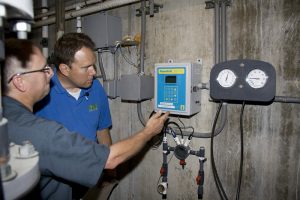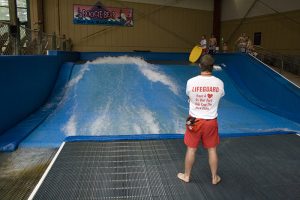Providing a healthy and safe swimming environment should be the primary goal for professionals working in the public and residential swimming pool markets. Having thorough understanding and training in proper disinfection is critical to protecting swimmers. The following is an overview on the most current methods of primary and secondary disinfection, and monitoring devices.
Automatic chemical controllers
Although the majority of public pool professionals are familiar with automated control systems, this technology is now finding its way into the residential market because they make it easier to maintain safe, healthy pool water, and lower the risk of disease. Initial costs of chemical sensors and control systems may curtail many from investing, yet the benefits outweigh these costs and should be presented to the pool owner.
Chemical controllers use microprocessors as the basis for operation. These microprocessors are designed to recognize low sanitizer levels, low or high pH levels, and make adjustments accordingly. Sophisticated systems will relay messages remotely. These messages can be very complex and have the ability to incorporate remote communication, log data on a continuous basis by means of digital readouts, and sound alarms to warn when the chemical parameters are out of range.
Monitoring chemical fluctuations is the main purpose; however, and many controllers will actually advise the pool owner when the system water flow is low so backwashing can be initiated. With the increase of wireless modems, these controllers can send messages to pagers, PDAs, smartphones, or to a combination of these devices. Chemical controllers should be calibrated regularly as the probes may become corroded or buildup with scale, requiring cleaning. Always follow the manufacturer’s instructions when cleaning and calibrating these controllers.
Salt systems
Electrolytic chlorine generators (ECGs) were introduced to the swimming pool industry in the early ’80s and were initially seen as expensive and awkward to install and use. Recent statistics now indicate an emergence of acceptance at both public and private pool installations. One of the main reasons for their growth in the industry is the system’s ability to deliver 100 per cent chlorine (Cl) by simply adding salt to the swimming pool.
These devices generate chlorine by separating ordinary salt (NaCl) into its basic chemical elements through a process called electrolysis. The ocean’s salt content is approximately 35,000 parts per million (ppm); human tears contain 4,000 to 9,000 ppm; and the human taste level of salt is approximately 3,500 ppm. Most manufacturers advise the salt content in swimming pool water to be 2,500 to 3,500 ppm. This mild saline solution is so low that it is almost impossible to taste the salt.
Retail sales will experience a boost once store staff is trained to explain the benefits of salt systems, e.g. bathers experience a smooth, silky feeling on their skin, no more red eyes, less skin irritation, faded swimwear, or chlorine smell. Finally, along with traditional sanitizers come important storage and handling safety concerns; however, with ECGs there is no need to store chlorine onsite, thus businesses can eliminate the facility and human risks associated with chemical storage, such as fire and explosions.
Oxidation reduction potential (ORP) monitors

As new bylaws and codes amend regulations to meet sanitizer demands, many are now requiring oxidation reduction potential (ORP) devices to measure chlorine activity.
Oxidation reduction potential relates to the oxidizing/reducing capability of the water by measuring the electron activity. The ORP probes only measure the ratio of oxidation. The electron activity is measured in millivolts with a recommended range between 650 to 750 mV.
ORP is only an indirect method to the approximate disinfectant level. Further, ORP measurements are influenced by the fluctuations in pH readings; therefore, as the pH level goes up, the millivolt reading on an ORP meter will go down, indicating the sanitizer is not as effective. Bringing the pH level down or adding more sanitizer will raise the millivolt reading. Although ORP does not specifically indicate the chlorine concentration in parts per million (ppm), it does indicate the effectiveness of the chlorine as an oxidizer.
It is also important for the operator to calibrate the probes as part of their routine maintenance as residue will build up on the probes and provide false readings. These are some of the reasons why manual testing with a N,N-diethyl-p-phenylenediamine (DPD) test kit is also required to ensure bather protection.
Even some residential ECG systems have incorporated ORP sensors to communicate with the unit to either turn the production of chlorine either on or off.
Ozone (O3)
The goal of all pool professionals is to eliminate risks from recreation water illnesses (RWIs) in the public and private pool market. There has been a greater acceptance of ozone technology as an effective means to prevent RWIs because it can improve public safety, as well as enhance water quality and reduce operating costs.
The acceptance of ozone has also spurred several manufacturers to interface their traditional sanitizers with ozone technology, delivering the ultimate water quality treatment.
There are two methods of ozone production:
- Corona discharge (CD), which uses electrical energy; and
- Ultraviolet (UV), which uses light energy.
Either method must be introduced into the circulation system downstream from all operating equipment and before the injection point of the residual disinfectant. CD generators produce ozone in higher concentrations and quantities in comparison to UV ozone generators. CD uses an electrical voltage—as air is exposed to the current, a ring of energy is created, which looks like a crown (corona). As air (or oxygen [O]) flows through the corona, the oxygen molecules are split apart and then combine back together to form (O3). When the pump is turned off, the ozonation process also ceases.

Ozone sanitizing improves water quality and bather comfort, while providing a safer, more pleasurable swimming experience.
Installing an ozone generator system will help to alleviate this concern because the DPBs are oxidized before they can affect bathers. Ozone sanitizing improves water quality and bather comfort, while providing a safer, more pleasurable swimming experience.
New technology for aquatic play features
Aquatic play features are growing in popularity and are not only found in waterparks anymore. Now they can be found at resorts, apartment complexes, and even in residential backyards. These unique interactive water environments require a special understanding of water care to prevent RWIs, which have been found at these facilities. As a result, more technologies are being adopted to reduce the risk.

Aquatic play features are growing in popularity and are not only found in waterparks anymore. Now they can be found at resorts, apartment complexes, and even in residential backyards.
With the growing popularity of these water environments, it is important for pool contractors, engineers, service technicians, and retail store staff to know how to explain, design, and retrofit these supplemental systems into new and existing aquatic facilities. Everyone is needed to help combat these dreaded waterborne pathogens that cause RWIs.
Learning how water care systems operate requires education and research to understand the differences between the various technologies. Technology is the future; therefore, it is important for all aquatic professionals to embrace knowledge and become educated by attending as many training opportunities as possible to provide a safe and healthy aquatic environment.
This article was written by Connie Sue Centrella and originally appeared on Pool & Spa Marketing [link].
